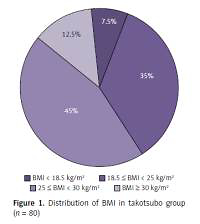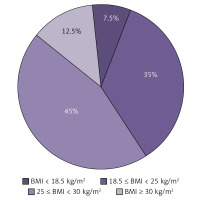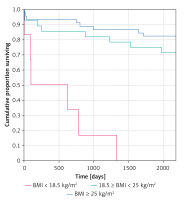Introduction
Takotsubo syndrome (TS) is a transient systolic dysfunction of the left ventricle, which is caused by stress. This particular syndrome is most frequently observed in postmenopausal women with minimal cardiovascular risk factors and the clinical course resembles acute coronary syndromes [1–3].
Takotsubo syndrome was first described by Sato et al., in 1990 [4]. For many years it was believed that the prognosis of patients with takotsubo was good. Nonetheless, subsequent follow-up studies revealed the possibility of severe complications that may occur during the early stage of the disease. Both early and late mortality is compared to mortality reported in non-ST segment elevation myocardial infarction (NSTEMI). Despite numerous clinical trials, the etiology of TS remains not entirely known, similarly to factors posing an influence on the prognosis [5–7].
The body mass index (BMI) is a well-recognized parameter used to evaluate nutrition disorders in adults. In our previous publication low BMI appeared to be a significant death risk factor during the 3-year observation of patients with TS, which prompted the authors to perform additional analyses [7].
The aim of this study was to assess the impact of body mass index on early and long-term prognosis in patients with TS.
Material and methods
During a 5-year period (2008–2012), TS was diagnosed in 101 patients treated in four invasive cardiology centres in Podlasie Province. Eighty patients (n = 80) with TTS diagnosis confirmed according to Mayo Clinic diagnostic criteria in force at the time and with an estimated BMI value were enrolled in the retrospective study [8]:
– transient hypokinesis, akinesis, or dyskinesis of the left ventricular mid-segments with or without apical involvement; the regional wall motion abnormalities extend beyond a single epicardial vascular distribution; a stressful trigger is often, but not always present,
– absence of obstructive coronary disease or angiographic evidence of acute plaque rupture,
– new electrocardiographic abnormalities (either ST-segment elevation and/or T-wave inversion) or modest elevation in cardiac troponin,
– absence of pheochromocytoma and myocarditis.
The negative medical history and the lack of clinical symptoms of myocarditis and pheochromocytoma have made it possible to recognize takotsubo.
Patients who were diagnosed with TS despite the presence of significant atherosclerotic lesions found in coronarography (n = 6), as well as 15 patients with unknown body mass, were excluded from the study.
Body mass index was calculated according to the Quetelet’s equation: body mass (kg)/height (m)2.
Patients were divided into 3 groups: group I (GI) – 6 (7.5%) patients with low body mass (BMI < 18.5 kg/m2), group II (GII) – 28 (35.0%) people with normal body mass (18.5 ≥ BMI < 25 kg/m2) and group III (GIII) – 46 (57.5%) patients with excessive body mass (BMI ≥ 25 kg/m2), including 10 obese patients with BMI ≥ 30 kg/m2. Figure 1 shows the BMI distribution in the takotsubo group.
The observational study was performed on average after 5.2 years based on the PESEL (personal identity number) register obtained from the Ministry of Interior and Administration. Mortality, regardless of the cause, stood as the main endpoint.
Statistical analysis
The obtained data were then analysed statistically. Student’s t-test and the Mann-Whitney U test were used to compare quantitative data, and the χ2 test along with Fisher’s test were used for qualitative data. All 3 groups of patients were compared in pairs. In the analysis of multiple comparisons, the Bonferroni correction was adopted. Survival analysis was conducted with the Kaplan-Meier estimator. Apart from factors that showed significant differences between groups, multivariate analysis, which was performed based on logistic regression method, focused on possible factors of considerable prognostic significance in patients with a history of acute coronary syndromes. Multivariate logistic regression analysis was carried out using the stepwise method. P < 0.05 was assumed as a statistically significant value. The Statistica 13.1 program was used to perform statistical analysis.
Results
The study included 80 patients aged 15–89 (mean: 67.9 years), 74 women and 6 men. Women accounted for 92.5% of the patients with takotsubo. There were no significant differences in the number of men and women in groups with low, normal and excessive BMI. Comparison of demographic and clinical data, parameters from diagnostic tests performed in 3 takotsubo groups is shown in the table (Table I).
Table I
Comparison of 3 groups of patients with takotsubo syndrome (n = 80)
* No atherosclerotic changes in coronary arteries – coronary arteries without any atherosclerotic lesions.
** Iinsignificant stenoses – presence of atherosclerotic lesions in the coronary arteries, which do not cause haemodynamically significant stenoses.
The average BMI value within the whole tested takotsubo group (n = 80) was 25.8 kg/m2, and the median was 25.7 kg/m2.
Patients with TS and BMI < 18.5 kg/m2 were older than patients assigned to groups II and III and they less frequently presented risk factors such as hypertension, hypercholesterolemia and positive family history of coronary artery disease. However, these patients smoked cigarettes more often and suffered from chronic obstructive pulmonary disease (COPD), depressive and anxiety disorders, as well as cancer.
In comparison to the other groups, in the group with BMI < 18.5 kg/m2, higher values of morphological parameters were found, as well as lower concentrations of troponin, creatine kinase, C-reactive protein (CRP) and lipid fractions.
Retrosternal pain was the main symptom of TS reported in each group. ECG usually showed ST elevation, including all patients with low body mass. Coronarography performed in patients with TS typically showed the presence of insignificant sclerotic lesions in coronary arteries, most frequently reported within the group with low BMI. Ventriculography and echocardiography performed in all TS patients showed contractility disorders within the scope of the left ventricular apex, with the average ejection fraction being slightly higher in the group with BMI < 18.5 kg/m2.
Comparison with the other groups showed that serious complications (sudden cardiac arrest, shock, pulmonary oedema, myocardial rupture) did not occur in the group with BMI < 18.5 kg/m2. The highest annual and 3-year mortality was reported in the group with BMI < 18.5 kg/m2, whereas after 5 years of follow-up all patients with low BMI were no longer alive (Table I, Figure 2). In group III, the mortality of overweight patients (25 ≥ BMI < 30 kg/m2) was 8.3%, and in obese patients (BMI ≥ 30 kg/m2) it was 20.0%. Body mass index over 25 kg/m2 (overweight and obese) was present in 57.5% of the population studied.
Multivariate analysis showed that risk factors associated with death during the 5-year follow-up period include low estimated glomerular filtration rate (eGFR), low BMI, low left ventricular ejection fraction, low total cholesterol levels and higher haemoglobin concentration (Table II).
Discussion
Obesity is considered to be a cardiovascular risk factor and simultaneously a factor which significantly increases the risk of complications subsequent to invasive procedures and surgical interventions. For decades it was believed that obesity worsens the prognosis among patients, but recent publications report a trend known as “the obesity paradox”. It appears that it may resemble the “cholesterol paradox” [9]. Multiple clinical trials devoted to cardiovascular diseases prove that after several years of observations the greatest mortality was observed among patients with low body mass or proper body mass, and the best prognosis was reported among overweight people [10, 11].
Takotsubo syndrome is a mysterious disease entity with its pathomechanism, prognostic, as well as predictive factors remaining not entirely known as it was recently stressed in the consensus documents on Takotsubo (acute ‘Stress’) cardiomyopathy [12, 13]. O’Rourke et al. [14] very recently have provided mechanisms to explain the syndrome of Takotsubo on the basis of Safar’s description of abnormalities of blood flow to the myocardium that occur independently of coronary narrowing [15]. These findings were supported by the Women Ischemia Syndrome Evaluation (WISE) study results [16, 17]. However, in this study of only 50 females, age (× 10 years), history of hypertension, history of diabetes, BMI (× 10), and aortic systolic pressure (× 10 mm Hg) contributed only about 24% of the variance in coronary flow reserve. In addition, mean BMI was 30.3 ±6.9 kg/m2 [16] and 72% had BMI over 25 kg/m2 [17]. What also remains unknown is the significance of nutrition disorders in the aetiology and the course of stress cardiomyopathy. Takotsubo syndrome is diagnosed not only in people with low body mass, as there are known cases of people suffering from anorexia, but also in obese patients [18–20]. On average, obese patients with TS constitute between 10–20% of the whole group [21, 22].
In our previous publication, low BMI proved to be a significant death risk factor during the 3-year observation of patients with TS [7], which prompted us to perform additional analyses in longer follow-up [7]. In recently published papers the BMI value is mainly described as the average value characterising the takotsubo group, or it is used to distinguish the group of obese patients [6, 23]. Desai et al. [24] stated that obese patients with TS revealed a higher risk of severe complications during the final stage of the disease (sudden cardiac arrest, cardiogenic shock, respiratory failure, necessity to implement devices providing left ventricular hemodynamic support), whereas in-hospital mortality was similar to values observed in the group of patients who were not obese. Surprisingly, in-hospital mortality of the patients with the lowest BMI was much lower than that of patients with acute heart failure, but 1-year mortality was significantly higher than in much older patients with acute heart failure [25]. A study by Shiomura et al. [26] focused on factors posing an influence on the quick/delayed improvement in the left ventricular contractile function (LV) in TS; as far as multivariate analysis is concerned BMI < 20 kg/m2 proved to a significant independent prognostic factor for quickly regaining LV contractility.
The prognosis for patients with TS is similar to the prognosis for patients with NSTEMI [5]. Due to considerably limited literature directly concerning the influence that BMI has on prognosis among patients with TS, the results obtained in this study have been related to patients with acute coronary syndromes. Patients with TS are less frequently reported to have an excessive body mass. In this study the average BMI value in patients with TS was 25.8 kg/m2. In other work, the average BMI value reported in groups of patients with TS was even lower: 21.4 kg/m2 in the study by Shiomura et al. [26]. The average BMI in patients with acute coronary syndromes was 27.3 kg/m2 in the study by Moscarella et al. [27] and in the meta-analysis performed by Lamelas et al. [28].
In the present study overweight patients constitute the biggest group (45%), people with normal body weight represent 35%, 12.5% of patients from the tested group were obese, while 7.5% of patients were underweight. Joyce et al. [29] reported that 51% of patients were overweight, 30% had normal body weight, and 19% people were obese. Similarly, in the study by Moscarella et al. [27], overweight patients amounted to nearly half (49.4%) of the group with NSTEMI, obese patients – 22.4% and people with normal BMI – 28.2%.
This paper focuses mainly on results obtained during the observational study in patients with low body mass (BMI < 18.5 kg/m2). Despite the fact that the early prognosis within this group is very good, since none of the patients died during the acute stage of the disease, the long-term prognosis is truly devastating. After 1 year, mortality in this group reached 15%, and after 5 years it was 100%. Patients with BMI < 18.5 kg/m2 were 9 years older than the remaining patients, which is the result of lower body weight in older patients. Undoubtedly, 100% mortality in this group of patients was also related to age. However, in a multivariate analysis, older age did not increase the risk of death as opposed to BMI. Even though the lowest mortality after 5 years was reported in overweight patients (15.2%), this value remains higher than in patients with acute coronary syndromes observed during a comparable follow-up period. Moscarella et al. [27] stated that after a 5-year follow-up period 9.5% of overweight patients were dead, slightly more patients with BMI < 25 – 13.7% and the smallest number of obese patients with STEMI – 6.3%. Joyce et al. [29] noted similar results obtained during a 5-year follow-up of patients after STEMI, as 13.6% of patients who were underweight or had normal body weight, and 9.1% of overweight and obese patients died.
The best 5-year prognosis for patients with TS and excessive body mass described in this study also confirms the so-called “obesity paradox” within the group of patients with TS. However, the fatal prognosis in underweight patients reveals a considerable prognostic significance of the BMI within this group of patients, which requires further observational studies in takotsubo groups, with special attention paid to the body mass index.
The greatest limitation related to this study lies in its retrospective character along with a small group of patients suffering from TS. The long-term study based on the PESEL database enabled us to obtain the information on patients’ dates of death, but the particular causes of death remain unknown.
In conclusion, the majority of typical cardiovascular risk factors are less frequently observed in patients with TS and low body mass. Early prognosis for patients with low BMI suffering from TS is good, but the 5-year follow-up is associated with very high (100%) mortality of these patients. Long-term observation reveals that the best prognosis concerns overweight patients (25 ≥ BMI < 30 kg/m2).





